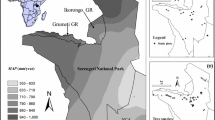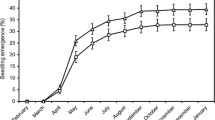Abstract
Aerial seed banks are potentially the main source of sexual recruitment for woody wetland plants. Whilst the importance of soil seed banks for the persistence and recruitment of wetland plants has been examined in many studies, the role of aerial seed banks has been largely neglected. We used seed traps and the seedling emergence technique to quantify the seed rain from aerial seed banks of the Swamp Paperbark Melaleuca ericifolia Sm. (Myrtaceae) in Dowd Morass, a Ramsar-listed, brackish-water wetland in south-eastern Australia. Nine plant species germinated from material collected in seed traps over 2004–2005, but emergents were dominated (80–97%) by M. ericifolia. The mean number of M. ericifolia emergents ranged from <1 to <100 seedlings m−2 day−1, and showed a peak in the summer–autumn period. Regression analysis showed a significant negative correlation (r 2 = 0.738) between the number of M. ericifolia emergents and water depth. Water depth and salinity were negatively correlated (r 2 = 0.819), and increases in the number of M. ericifolia emergents as water levels fell were also associated with high salinities. Increasing air temperature and vapour pressure deficit also stimulated seed release during periods of drying. This study is one of the first to demonstrate the importance of aerial seed banks for sexual recruitment in woody wetland plants and the release of seed in relation to environmental factors. Aerial seed banks warrant consideration alongside soil seed banks for the establishment and long-term survival of woody plants in wetlands.




Similar content being viewed by others
References
Abernethy, V. J. & N. J. Willby, 1999. Changes along a disturbance gradient in the density and composition of propagule banks in floodplain aquatic habitats. Plant Ecology 140: 177–190.
Baldwin, A. H., K. L. McKee & I. A. Mendelssohn, 1996. The influence of vegetation, salinity and inundation on seed banks of oligohaline coastal marshes. American Journal of Botany 83: 470–479.
Barrett, L. G., T. H. He, B. B. Lamont & S. L. Krauss, 2005. Temporal patterns of genetic variation across a 9-year-old aerial seed bank of the shrub Banksia hookeriana (Proteaceae). Molecular Ecology 14: 4169–4179.
Bird, E. C. F., 1962. The Swamp Paper-bark. The Victorian Naturalist 79: 72–81.
Boedeltje, G., J. P. Bakker & G. N. J. Ter Heerdt, 2003. Potential role of seed banks in the development of aquatic vegetation in backwaters along navigation canals. Aquatic Botany 77: 53–69.
Britton, D. L. & M. A. Brock, 1994. Seasonal germination from wetland seed banks. Australian Journal of Marine and Freshwater Research 45: 1445–1457.
Brock, M. A. & D. L. Britton, 1995. The role of seed banks in the revegetation of Australian temporary wetlands. In Wheeler, B., S. Shaw, W. Fojt & A. Robertson (eds), The Restoration of Temperate Wetlands. Wiley, Chichester: 183–188.
Brown, D., 1992. Estimating the composition of a forest seed bank: a comparison of the seed extraction and seedling emergence methods. Canadian Journal of Botany 70: 1603–1612.
Capon, S. J. & M. A. Brock, 2006. Flooding, soil seed bank dynamics and vegetation resilience of a hydrologically variable desert floodplain. Freshwater Biology 51: 206–223.
Cremer, K. W., 1965. How eucalypt fruits release their seed. Australian Journal of Botany 13: 11–16.
de Jong, M., 1997. Register of Wetland Restoration Projects in Australia and New Zealand. Wetlands Management Program, Department of Environment and Natural Resources, Adelaide.
Denton, M. & G. G. Ganf, 1994. Response of juvenile Melaleuca halmaturorum to flooding: management implications for a seasonal wetland, Bool Lagoon, South Australia. Australian Journal of Marine and Freshwater Research 45: 1395–1408.
Doran, J. C. & B. V. Gunn, 1994. Exploring the genetic resources of tropical melaleucas. Forest Genetic Resources 22: 12–24.
Enright, N. J. & D. Goldblum, 1999. Demography of a non-sprouting & resprouting Hakea species (Proteaceae) in fire-prone Eucalyptus woodlands of southeastern Australia in relation to stand age, drought and disease. Plant Ecology 144: 71–82.
Fowler, N. L., 1988. What is a safe site?: Neighbor, litter, germination date, and patch effects. Ecology 69: 947–961.
Goubitz, S., M. J. A. Werger & G. Ne’eman, 2003. Germination response to fire-related factors of seeds from non-serotinous and serotinous cones. Plant Ecology 169: 195–204.
Harris, W., 2002. Variation of inherent seed capsule splitting in populations of Leptospermum scoparium (Myrtaceae) in New Zealand. New Zealand Journal of Botany 40: 405–417.
Kollmann, J. & D. Goetze, 1998. Notes on seed traps in terrestrial plant communities. Flora 193: 31–40.
Kozlowski, T. T., 1997. Responses of woody plants to flooding and salinity. Tree Physiology Monograph 1: 1–29.
Ladiges, P. Y., P. C. Foord & R. J. Willis, 1981. Salinity and waterlogging tolerance of some populations of Melaleuca ericifolia Smith. Australian Journal of Ecology 6: 203–215.
Liu, G. H., W. Li, E. H. Li, L. Y. Yuan & A. J. Davy, 2006. Landscape-scale variation in the seed banks of floodplain wetlands with contrasting hydrology in China. Freshwater Biology 51: 1862–1878.
Middleton, B. A., 2000. Hydrochory, seed banks, and regeneration dynamics along the landscape boundaries of a forested wetland. Plant Ecology 146: 169–184.
Middleton, B. A., 2003. Soil seed banks and the potential restoration of forested wetlands after farming. Journal of Applied Ecology 40: 1025–1034.
Nicol, J. M., G. G. Ganf & G. A. Pelton, 2003. Seed banks of a southern Australian wetland: the influence of water regime on the final floristic composition. Plant Ecology 168: 191–205.
Page, M. J., L. Newlands & J. Eales, 2002. Effectiveness of three seed-trap designs. Australian Journal of Botany 50: 587–594.
Parker, V. T. & M. A. Leck, 1985. Relationships of seed banks to plant distribution patterns in a freshwater tidal wetland. American Journal of Botany 72: 161–174.
Pettit, N. E. & R. H. Froend, 2001. Variability in flood disturbance and the impact on riparian tree recruitment in two contrasting river systems. Wetlands Ecology and Management 9: 13–25.
Quinn, G. P. & M. J. Keogh, 2002. Experimental Design and Data Analysis for Biologists. Cambridge University Press, Cambridge.
Raulings, E. J., P. I. Boon, P. C. Bailey, M. C. Roache, K. Morris & R. Robinson, 2007. Rehabilitation of Swamp Paperbark (Melaleuca ericifolia) wetlands in south-eastern Australia: effects of hydrology, microtopography, plant age and planting technique on the success of community-based revegetation trials. Wetlands Ecology and Management 15: 175–188.
Rayamajhi, M. B., T. K. Van, T. D. Center, J. A. Goolsby, P. D. Pratt & A. Racelis, 2002. Biological attributes of the canopy-held melaleuca seeds in Australia and Florida. U.S. Journal of Aquatic Plant Management 40: 87–91.
Roberts, H. A., 1981. Seed banks in soils. In Cóaker, T. H. (ed.), Advances in Applied Biology. Academic Press, London: 1–55.
Russell-Smith, J. & S. A. Setterfield, 2006. Monsoon rain forest seedling dynamics, northern Australia: contrasts with regeneration in eucalypt-dominated savannas. Journal of Biogeography 33: 1597–1614.
Salter, J., K. Morris, P. C. E. Bailey & P. I. Boon, 2007. Interactive effects of salinity and water depth on the growth of Melaleuca ericifolia Sm. (Swamp paperbark) seedlings. Aquatic Botany 86: 213–222.
Salter, J., K. Morris & P. I. Boon, 2008. Does salinity reduce the tolerance of two contrasting wetland plants, the submerged monocot Vallisneria australis and the woody shrub Melaleuca ericifolia, to wetting and drying? Marine and Freshwater Research 59: 291–303.
Schneider, R. L. & R. R. Sharitz, 1988. Hydrochory and regeneration in a bald cypress-water tupelo swamp forest. Ecology 69: 1055–1063.
Schwilk, D. W. & D. D. Ackerly, 2001. Flammability and serotiny as strategies: correlated evolution in pines. Oikos 94: 326–336.
Tapias, R., J. Climent, J. A. Pardos & L. Gil, 2004. Life histories of Mediterranean pines. Plant Ecology 171: 53–68.
van der Valk, A. G. & C. B. Davis, 1978. The role of seed banks in the vegetation dynamics of prairie glacial marshes. Ecology 59: 322–335.
Woodall, S. L., 1982. Seed dispersal in Melaleuca quinquenervia. Florida Scientist 45: 81–93.
Acknowledgements
We are grateful to John Topp from Gippsland Indigenous Plants for his assistance in collecting the seed trap material. We thank Jacqueline Salter, Elizabeth Wallis, Shauna Tupper and Dr Ni Watiniasih for access to their data. We also thank Dr Ross Thompson and the two anonymous reviewers for their invaluable comments and suggestions on earlier drafts of this paper.
Author information
Authors and Affiliations
Corresponding author
Additional information
Handling editor: Luis Mauricio Bini
Rights and permissions
About this article
Cite this article
Hamilton-Brown, S., Boon, P.I., Raulings, E. et al. Aerial seed storage in Melaleuca ericifolia Sm. (Swamp Paperbark): environmental triggers for seed release. Hydrobiologia 620, 121–133 (2009). https://doi.org/10.1007/s10750-008-9623-6
Received:
Revised:
Accepted:
Published:
Issue Date:
DOI: https://doi.org/10.1007/s10750-008-9623-6




